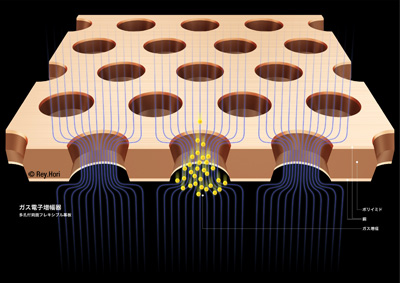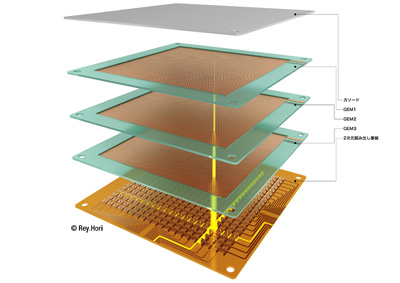The project is aiming to promote a 2D micro-pattern gas detector technology for various fields as well as particle and nuclear physics experiments. A new type of activity has started for the fundamental R&D work convened by the university researchers, where very basic properties or new structures/fabrication methods of MPGD are investigated.
GEM is a type of micro-pattern gaseous detector (MPGD) developed by the MPGD group in the Detector Technology Project (DTP) at KEK. Invented by CERN physicist Fabio Sauli in 1996, GEM was already a well-established technology when Prof. Shoji Uno of KEK proposed the use of advanced GEM detector technology for small-scale radiation experiments.
“Traditionally at KEK, particle and nuclear experimentalists are very keen in the field of advanced detector technology developments, but previously did not actively share their expertise with researchers in other disciplines. “The idea of the MPGD project at DTP is to develop a high-quality GEM that is easily accessible to non detector experts.” The GEM, incorporated with the general-purpose data acquisition system (DAQ) developed by the DAQ project in DTP, has the potential to detect many types of ionizing radiation such as neutrons, X-rays, charged particles, and ultraviolet light.
- Flexible geometry and multi-purpose detector-
GEM is a gaseous ionization detector, in which incoming particles ionize the gas inside the chamber, producing electrons. An essential feature of all gaseous ionization detectors is the amplification of the resulting electrons by a factor of millions or more. The amplification depends on the application of a high voltage. Without amplification, sensors are not sensitive enough to detect the initial small electron signals. For example, in a wire chamber, a high voltage is applied to sense wires that run the length of the chamber.

Fig. 1. Photo of GEM foil taken by an electron microscope

Fig.2 Image of gas amplification by high electric field in a GEM hole.
The blue lines in this figure are electrical flux lines.

Fig.3 Image of gas amplification with triple GEM and of signal readout
from 2D readout strip.
Multiple GEM are used to obtain enough signal output.
The applied high voltage of each GEM are optimized by stable operation and signal amplitude.